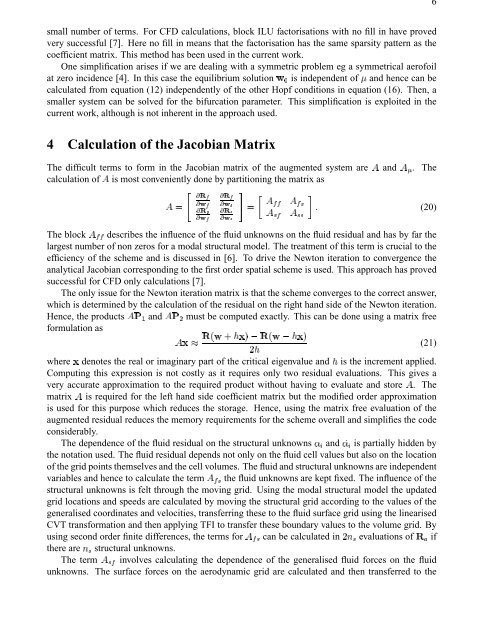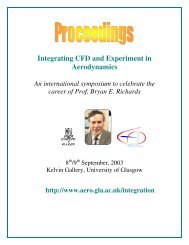IFASD Paper 2003 - CFD4Aircraft
IFASD Paper 2003 - CFD4Aircraft
IFASD Paper 2003 - CFD4Aircraft
Create successful ePaper yourself
Turn your PDF publications into a flip-book with our unique Google optimized e-Paper software.
£<br />
h<br />
¨<br />
¨<br />
¤<br />
¤<br />
<br />
¬<br />
¬<br />
¡<br />
£<br />
¨<br />
¨<br />
<br />
£<br />
€<br />
¡<br />
£<br />
€<br />
£<br />
a<br />
6<br />
small number of terms. For CFD calculations, block ILU factorisations with no fill in have proved<br />
very successful [7]. Here no fill in means that the factorisation has the same sparsity pattern as the<br />
coefficient matrix. This method has been used in the current work.<br />
One simplification arises if we are dealing with a symmetric problem eg a symmetrical aerofoil<br />
at zero incidence [4]. In this case the equilibrium solution ¡}| is independent of k and hence can be<br />
calculated from equation (12) independently of the other Hopf conditions in equation (16). Then, a<br />
smaller system can be solved for the bifurcation parameter. This simplification is exploited in the<br />
current work, although is not inherent in the approach used.<br />
4 Calculation of the Jacobian Matrix<br />
The difficult terms to form in the Jacobian matrix of the augmented system € are<br />
calculation € of is most conveniently done by partitioning the matrix as<br />
and € £ . The<br />
(20)<br />
£«£<br />
¤6<br />
€ §©¨«ªI¬<br />
¨«ªI¬<br />
°<br />
£²£<br />
€ The block describes the influence of the fluid unknowns on the fluid residual and has by far the<br />
largest number of non zeros for a modal structural model. The treatment of this term is crucial to the<br />
efficiency of the scheme and is discussed in [6]. To drive the Newton iteration to convergence the<br />
analytical Jacobian corresponding to the first order spatial scheme is used. This approach has proved<br />
successful for CFD only calculations [7].<br />
The only issue for the Newton iteration matrix is that the scheme converges to the correct answer,<br />
which is determined by the calculation of the residual on the right hand side of the Newton iteration.<br />
Hence, the €5„ \ products €†„ and<br />
formulation as<br />
¨«ª<br />
¨«ª<br />
€5a…a,± S<br />
must be computed exactly. This can be done using a matrix free<br />
^J §µ´ ` +~V“^9 V´ ` +<br />
€w`J³<br />
Ÿ´<br />
` where denotes the real or imaginary part of the critical eigenvalue ´ and is the increment applied.<br />
Computing this expression is not costly as it requires only two residual evaluations. This gives a<br />
very accurate approximation to the required product without having to evaluate and € store . The<br />
€ matrix is required for the left hand side coefficient matrix but the modified order approximation<br />
is used for this purpose which reduces the storage. Hence, using the matrix free evaluation of the<br />
augmented residual reduces the memory requirements for the scheme overall and simplifies the code<br />
considerably.<br />
The dependence of the fluid residual on the structural d unknowns > d and is partially hidden by<br />
the notation used. The fluid residual depends not only on the fluid cell values but also on the location<br />
of the grid points themselves and the cell volumes. The fluid and structural unknowns are independent<br />
variables and hence to calculate the € a term the fluid unknowns are kept fixed. The influence of the<br />
structural unknowns is felt through the moving grid. Using the modal structural model the updated<br />
grid locations and speeds are calculated by moving the structural grid according to the values of the<br />
generalised coordinates and velocities, transferring these to the fluid surface grid using the linearised<br />
CVT transformation and then applying TFI to transfer these boundary values to the volume grid. By<br />
using second order finite differences, the terms € for<br />
there œa are structural unknowns.<br />
The €ta term involves calculating the dependence of the generalised fluid forces on the fluid<br />
unknowns. The surface forces on the aerodynamic grid are calculated and then transferred to the<br />
(21)<br />
a can be calculated in Ÿ œa evaluations of ^ r if<br />
¤ ¯®<br />
€ta

















